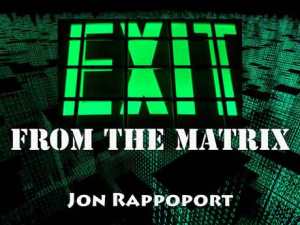Beyond one space-time continuum: logic and imagination
by Jon Rappoport
July 16, 2015
Logic applies to the physical universe.
It applies to statements made about that universe. It applies to factual language.
Many wonderful things can be done with logic. Don’t leave home without it. Don’t analyze information without it. Don’t endure an education without it.
But art and imagination are of another universe(s). They can deploy logic, but they can also invent in any direction without limit, and they can embrace contradiction. They can build worlds in which space and time and energy are quite different.
Magic is nothing more and nothing less than imagination superseding this universe. Magic occurs when imagination takes this reality for a ride.
Which brings us to what I call the Is People. The Is People are dedicated with a fervor to insisting that this Continuum and this consensus reality are inviolable, are the end-all and be-all.
They strive to fit themselves into Is, and this eventually has some interesting negative consequences. They come to resemble solid matter. They take on the character of matter.
For them, imagination is at least a misdemeanor, if not a felony. It’s a blow to the Is of Is. They tend to view imagination as a form of mental disorder.
Technocrats like to gibber about imagination as if it’s nothing more than just another closed system that hasn’t been mapped yet. But they’re sure it will be, and when that happens, people will apparently give up creating and opt for living in a way that more closely resembles machines.
There are many people who secretly wish they were machines that functioned automatically and without flaws. It’s their wet dream.
Magic eventually comes to the conclusion that imagination creates reality. Any reality. And therefore, one universe, indivisible, is an illusion, a way of trapping Self.
What began as the physical universe, a brilliant work of art, ends up as a psychic straitjacket, a mental ward in which the inmates strive for normalcy. Those who fail at even this are labeled and shunted into a special section of the ward.
But the result of imagination, if pursued and deployed long enough and intensely enough, is:
Consensus reality begins to organize itself around you, rather than you organizing yourself around it.
There are various names and labels used to describe this state of affairs, but none of them catches the sensation of it.
Magic is one of those labels.
What I’m describing here isn’t some snap-of-the-fingers trick of manifestation; it’s a life lived.
The old alchemists were working in this area. They were striving for the transformation of consciousness. In true alchemy, one’s past, one’s experience, one’s conflicts all become fuel for the fire of creating new realities. Taken along certain lines, this is called art.
One universe, one logic, one Continuum, one role in that Continuum, one all-embracing commitment to that role, one avenue of perception, one Is…this is the delusion.
And eventually, the delusion gives birth to a dedication to what “everyone else” thinks and supposes and assumes and accepts. This is slavery.
Freeing one’s self, living through and by imagination, is not a mass movement. It’s a choice taken by one person. It’s a new and unique road for each person.
Societies and civilizations are organized around some concept of the common good. The concept always deteriorates, and this is because it is employed to lower the ceiling on individual power rather than raise it.
“Be less than you are, then we can all come together in a common cause.”
It’s essentially a doctrine of sacrifice—everyone sacrifices to everyone else, and the result is a coagulated mass of denial of Self.
It is a theme promoted under a number of guises by men who have one thing in mind: control.
It’s a dictatorship of the soul. It has always existed.
Breaking out of it involves reasserting the power of imagination to invent new and novel realities.
Under a variety of names, this is art.
Promoting the image of the artist as a suffering victim is simply one more way to impose the doctrine of sacrifice.
In 1961, when I began writing and painting in earnest, I had a conversation with the extraordinary healer, Richard Jenkins, whom I write about in my book, The Secret Behind Secret Societies (included in Exit From The Matrix). This is my note from that time about what Richard told me:
“Paint what you want to, no matter what anyone else says. You may not always know what you want to create, but that’s good. Keep working, keep painting. You’ll find your way. You’ll invent something new, something unique, if you don’t give in. You’ll see everything in a new light. Reality is a bad joke. It’s nothing more than what everyone assents to, because they’re afraid. They’re afraid of what people will say. They’re afraid they have far more power than they want to discover. They’re afraid that power will lead them away from common and ordinary beliefs. They’re afraid they’ll become a target for the masses who have surrendered their own lives and don’t want to be reminded of it. They afraid they’ll find out something tremendous about themselves…”
Nothing I’ve experienced in the 50 years since then has diminished what Richard said to me.
These fears are all illusions that disintegrate when a person shoves in his chips on imagination and makes that bet and lives it.
Here are several notes from the years 1999-2010, while I was preparing my collection, The Matrix Revealed. They take up the subject of reality-construction, mind control, mind freedom, and creative power.
“You have to understand that there are dimensions. In the dimension we call the world, a person needs logic. He needs it badly. He needs to be able to analyze and take apart things and put them back together again. He needs to identify flaws in reasoning and discover deceptions. He needs to recognize formal arguments and trace them all the way through from assumptions to conclusions. But in the dimension where creative power operates, where things happen that most certainly impact this world, all bets are off. He needs to understand and experience and launch a kind of vast freedom for his own imagination that takes him entirely out of the realm of being a normal person, a provincial “realist,” a mechanically thinking human. He has to go light-years past that. He has to stop pretending he is some kind of scientist. In other words, he has to stop burying his own creative power. Two dimensions, two capabilities.”
“Mind control, brainwashing, programming, conditioning all refer to the imposition of systems on the human creative impulse. When you have a whole civilization that, more and more, consists of systems, you have an effort to replace the individual with the group, with the machine.”
“At the highest level, elites are in the business of inventing reality for everyone else. This is more than lying. It’s the wholesale invention of a continuum. Past, present, and future.”
“Imagination is the opposite of mind control. It is creating beyond the boundaries of accepted reality. It is more than perception. Imagination expands perception.”
“Elites are perverse artists who invent reality for everyone else. Part of the plan is convincing everyone else that they can’t invent their own far-reaching reality.”
“Most people define freedom as liberation from certain externally imposed restrictions. But freedom goes much farther than that. It goes beyond how individuals ordinarily define their own existence, their own concerns, their own habits. A person’s own definitions are self-imposed limits. These limits = everything a person does and thinks that excludes imagination.”
Jon Rappoport
The author of three explosive collections, THE MATRIX REVEALED, EXIT FROM THE MATRIX, and POWER OUTSIDE THE MATRIX, Jon was a candidate for a US Congressional seat in the 29th District of California. He maintains a consulting practice for private clients, the purpose of which is the expansion of personal creative power. Nominated for a Pulitzer Prize, he has worked as an investigative reporter for 30 years, writing articles on politics, medicine, and health for CBS Healthwatch, LA Weekly, Spin Magazine, Stern, and other newspapers and magazines in the US and Europe. Jon has delivered lectures and seminars on global politics, health, logic, and creative power to audiences around the world. You can sign up for his free NoMoreFakeNews emails here or his free OutsideTheRealityMachine emails here.


